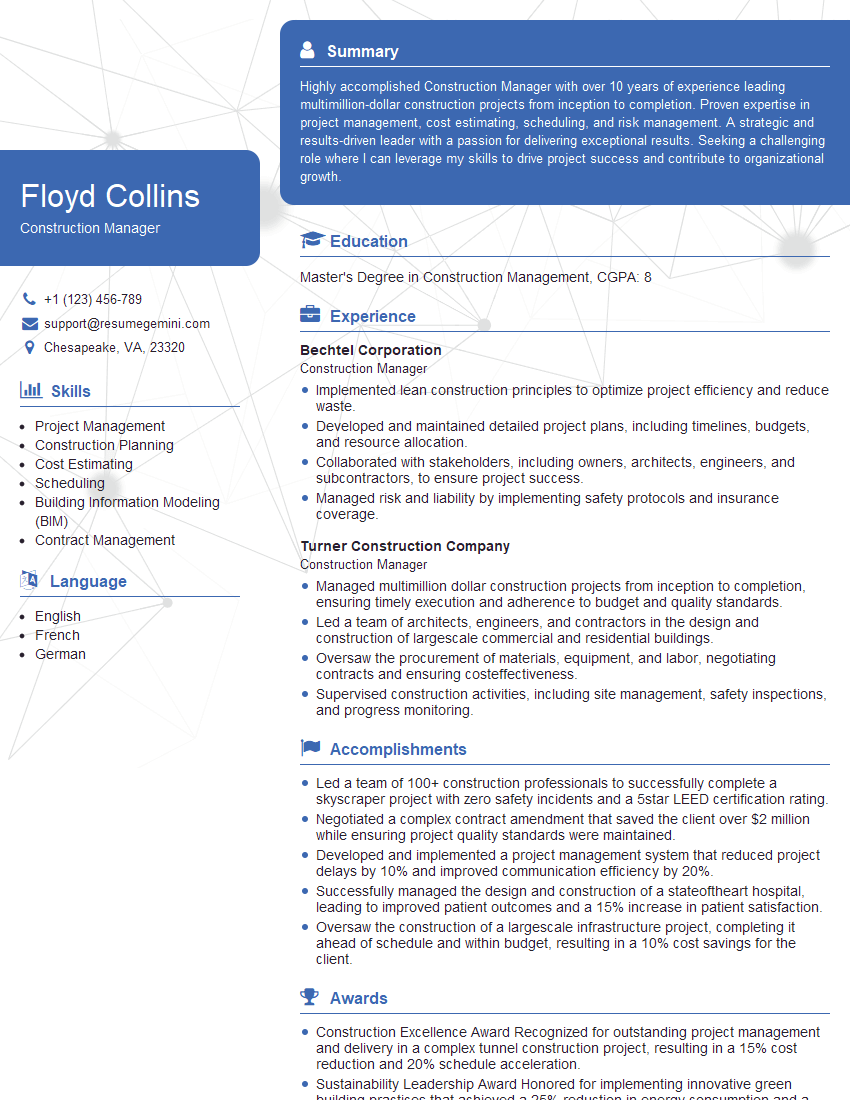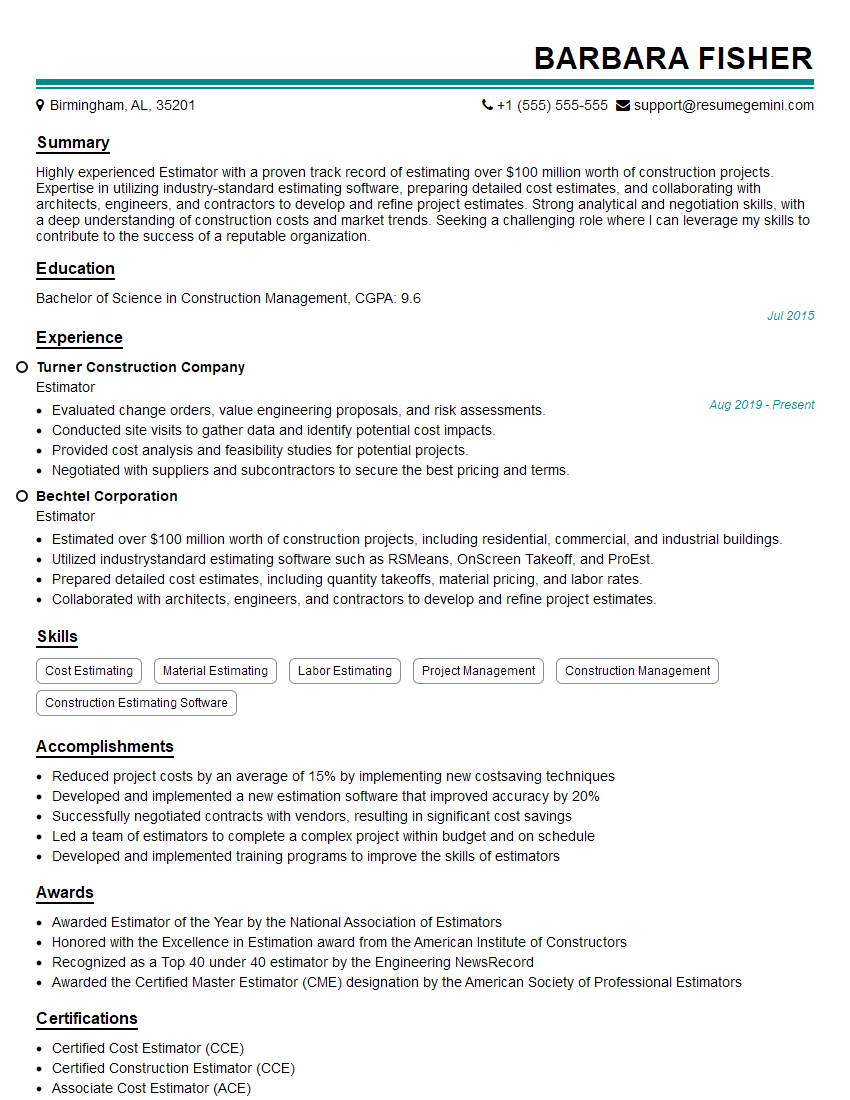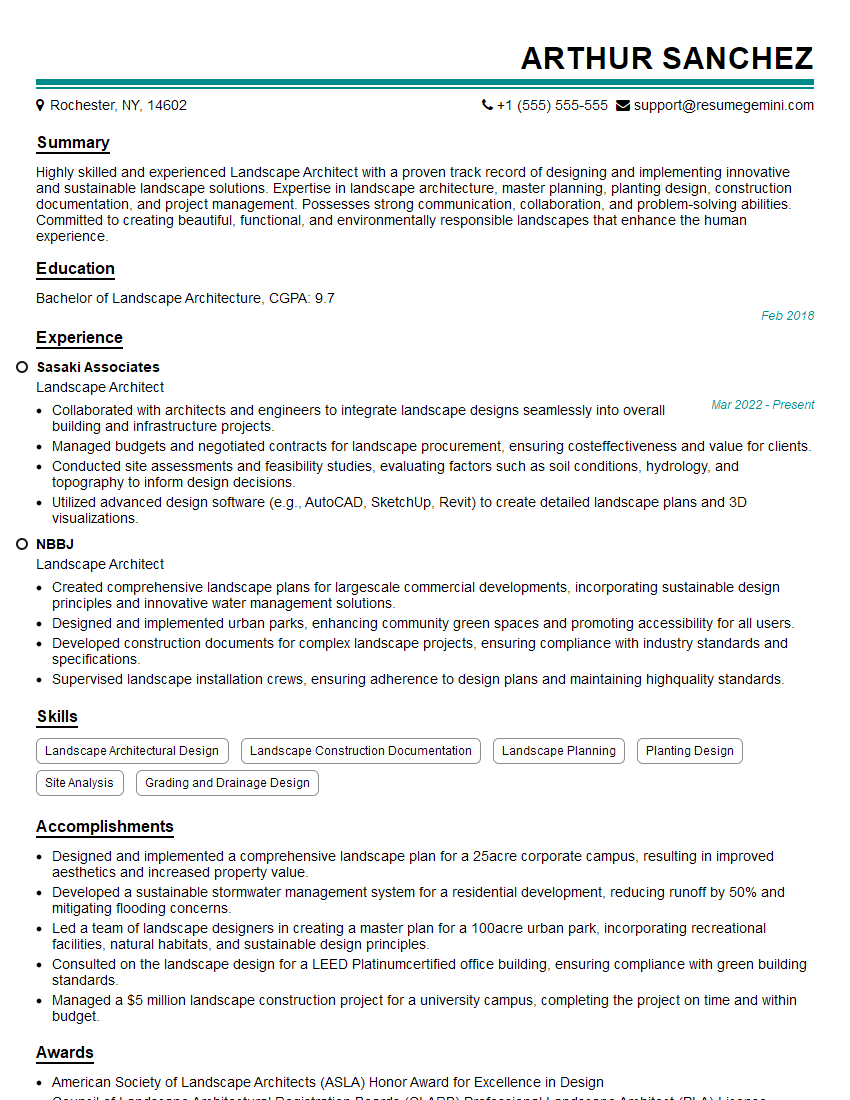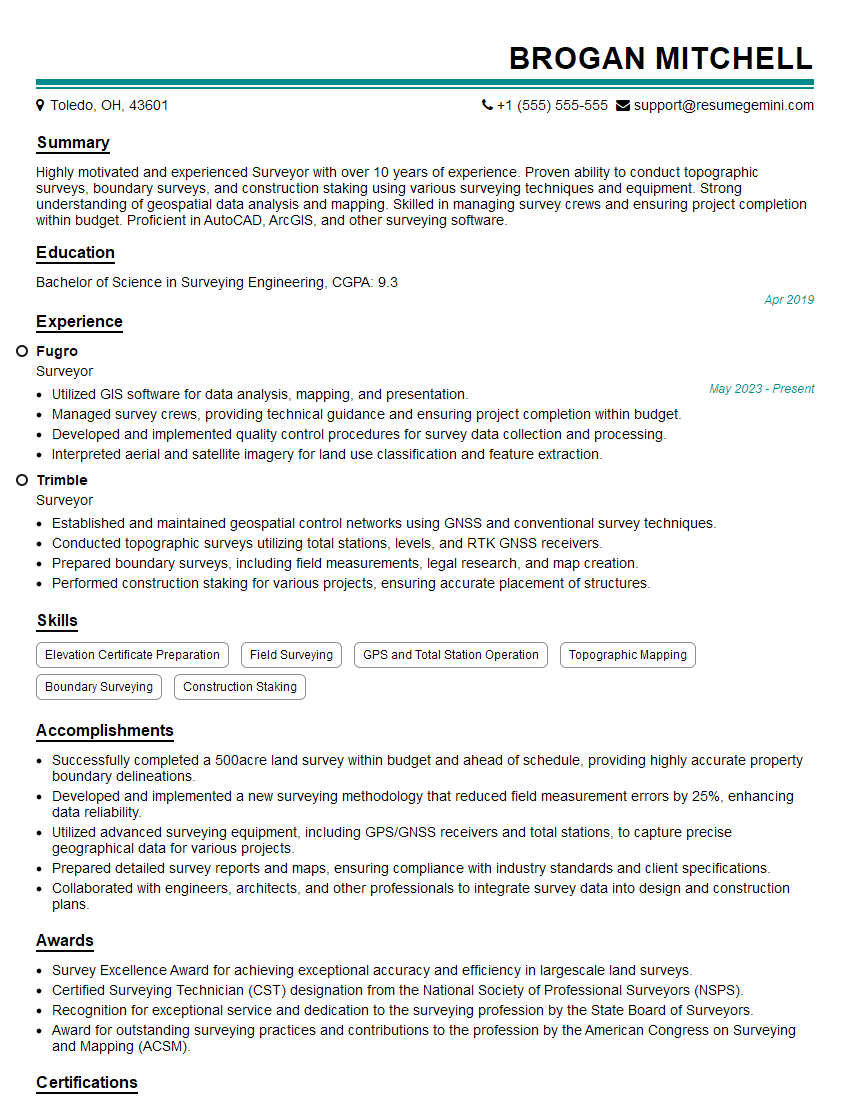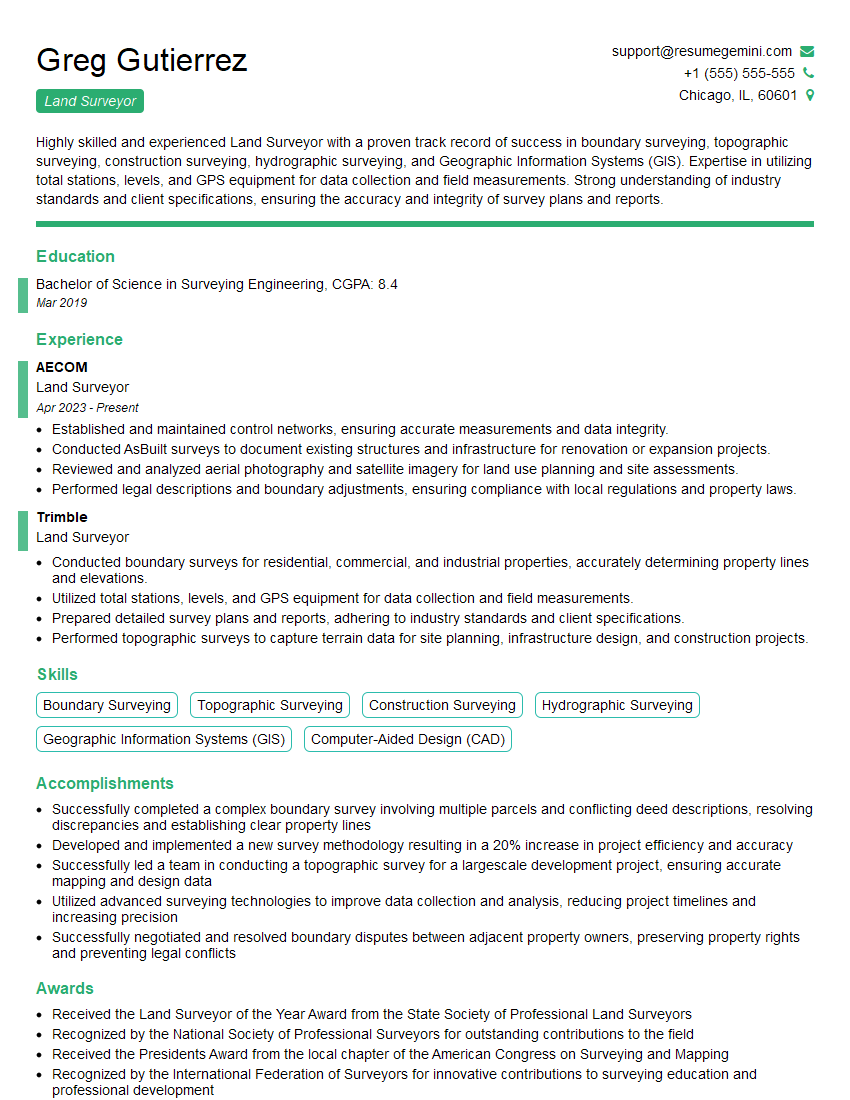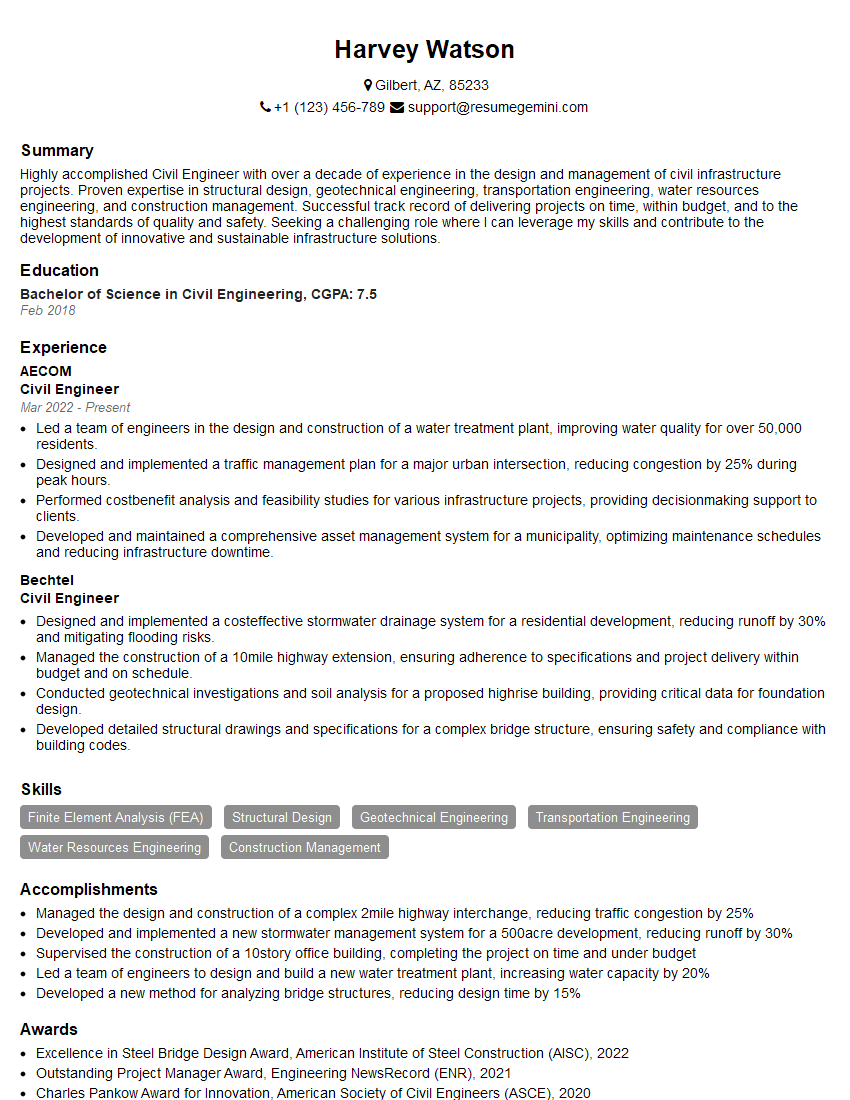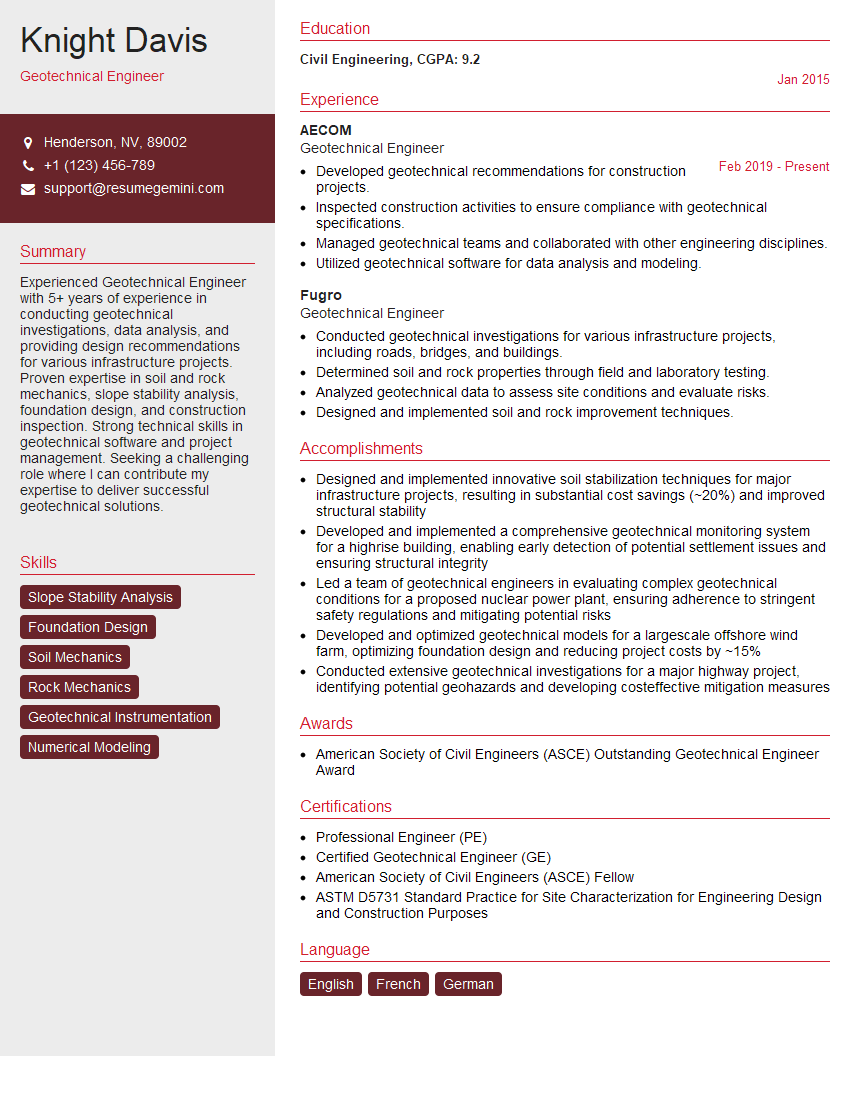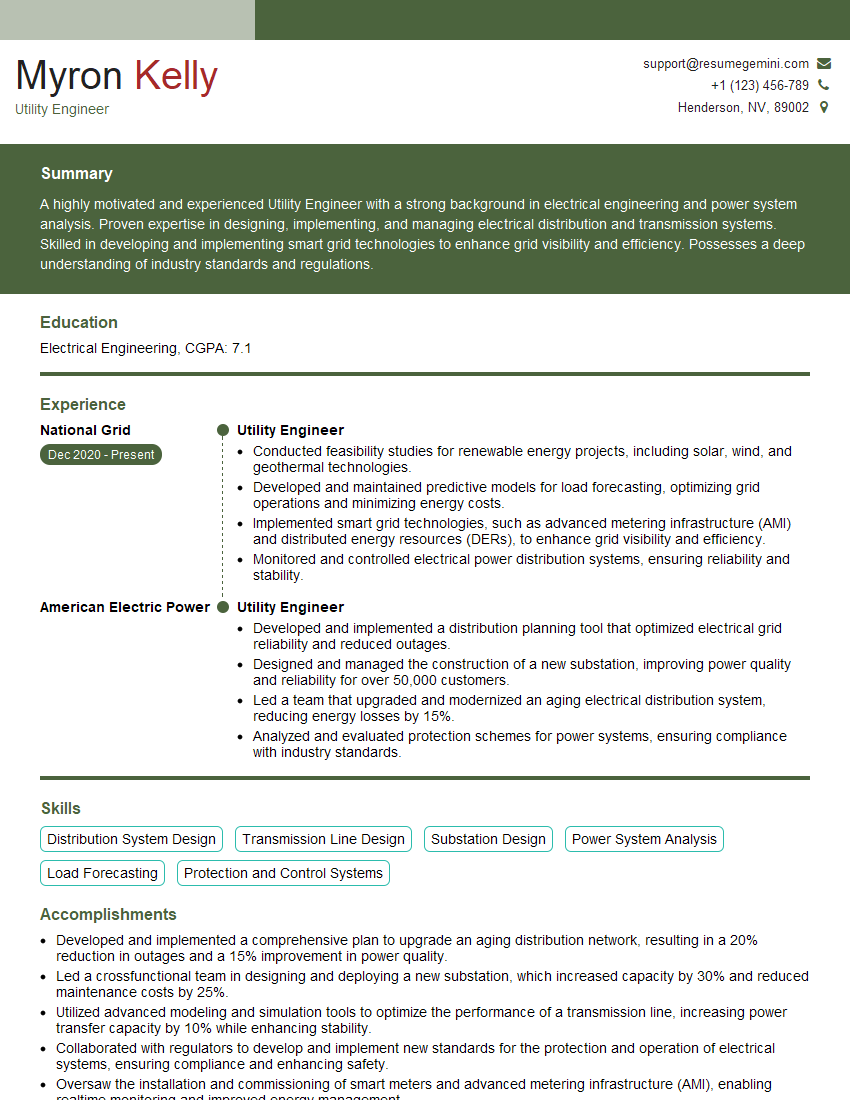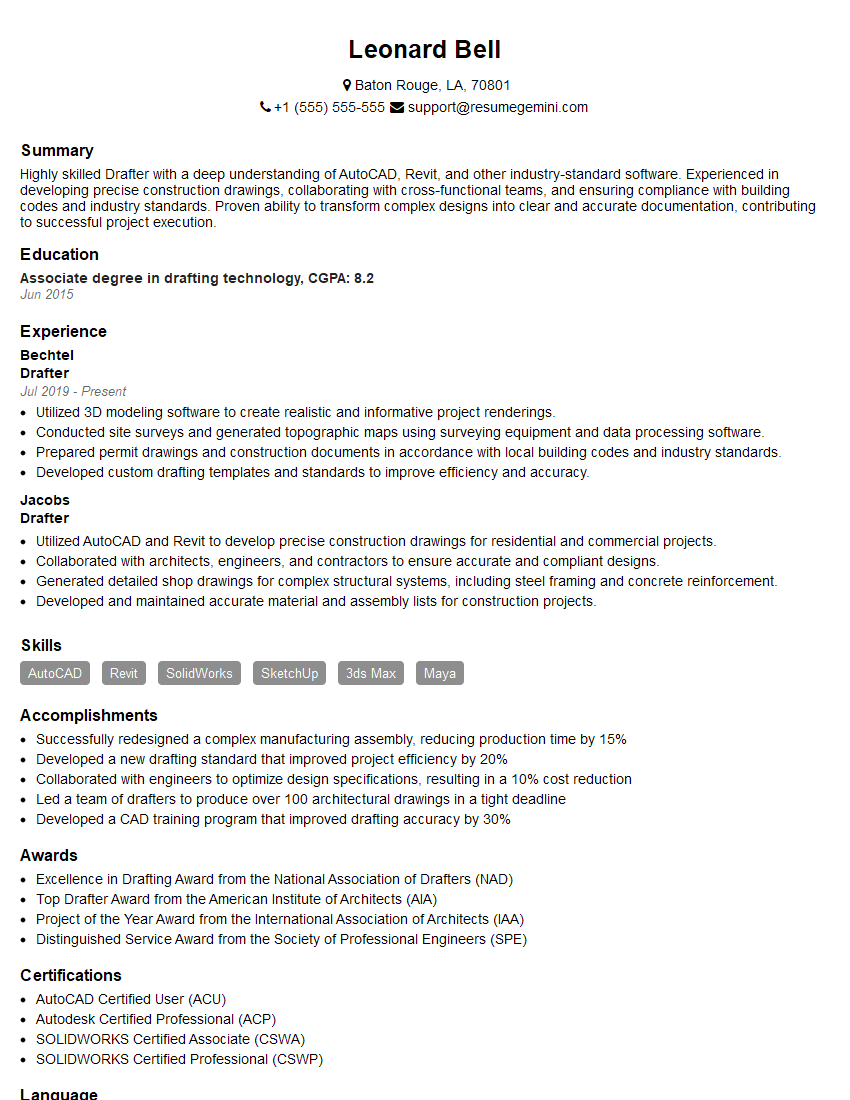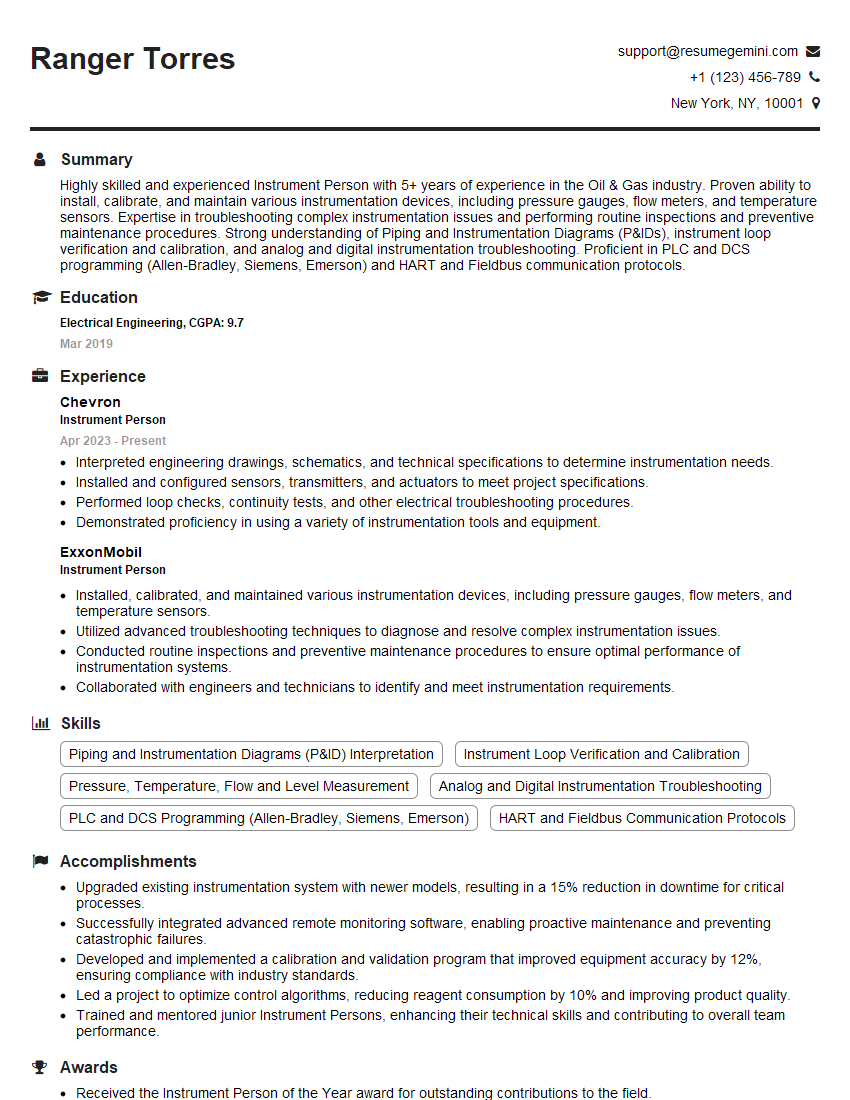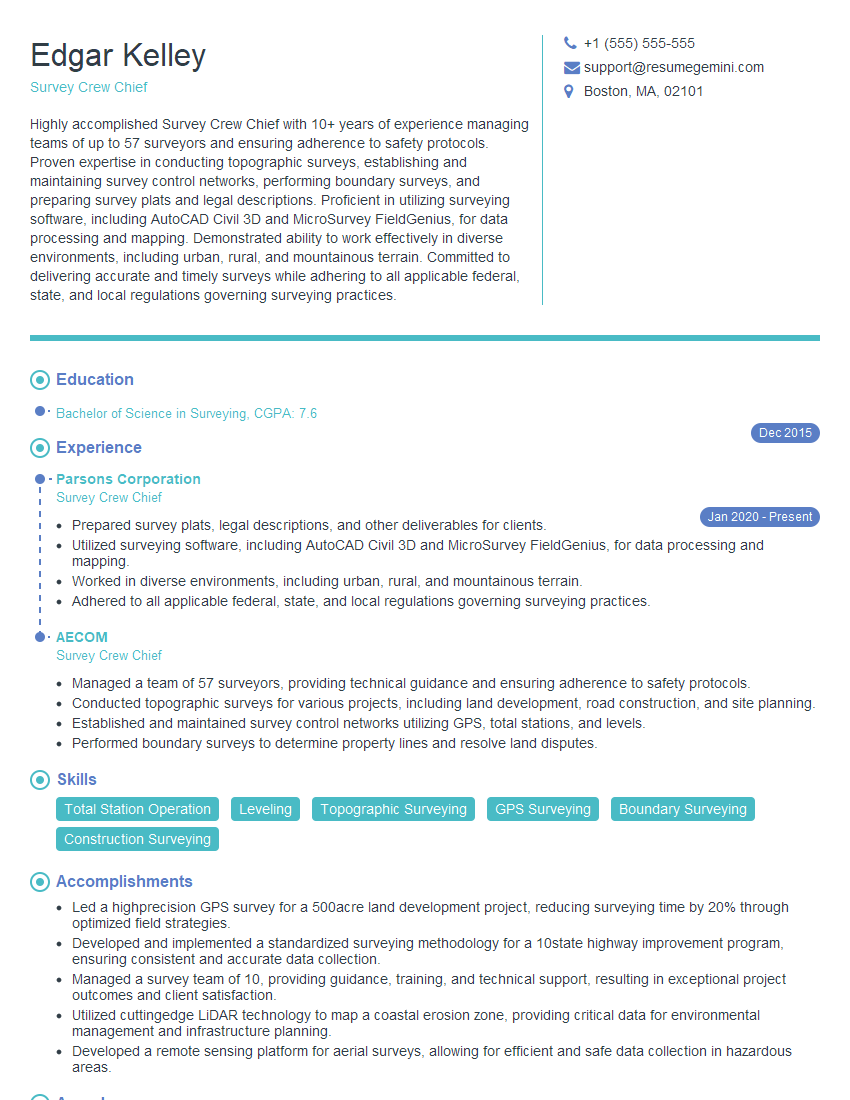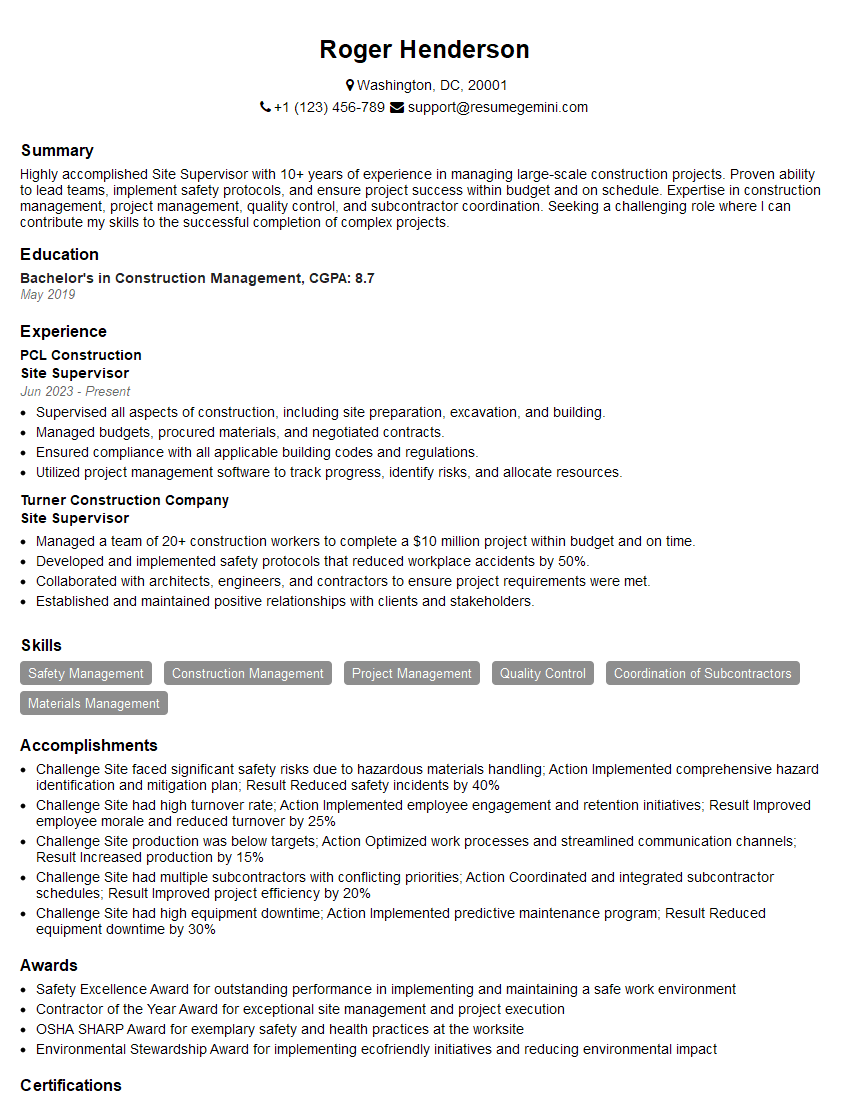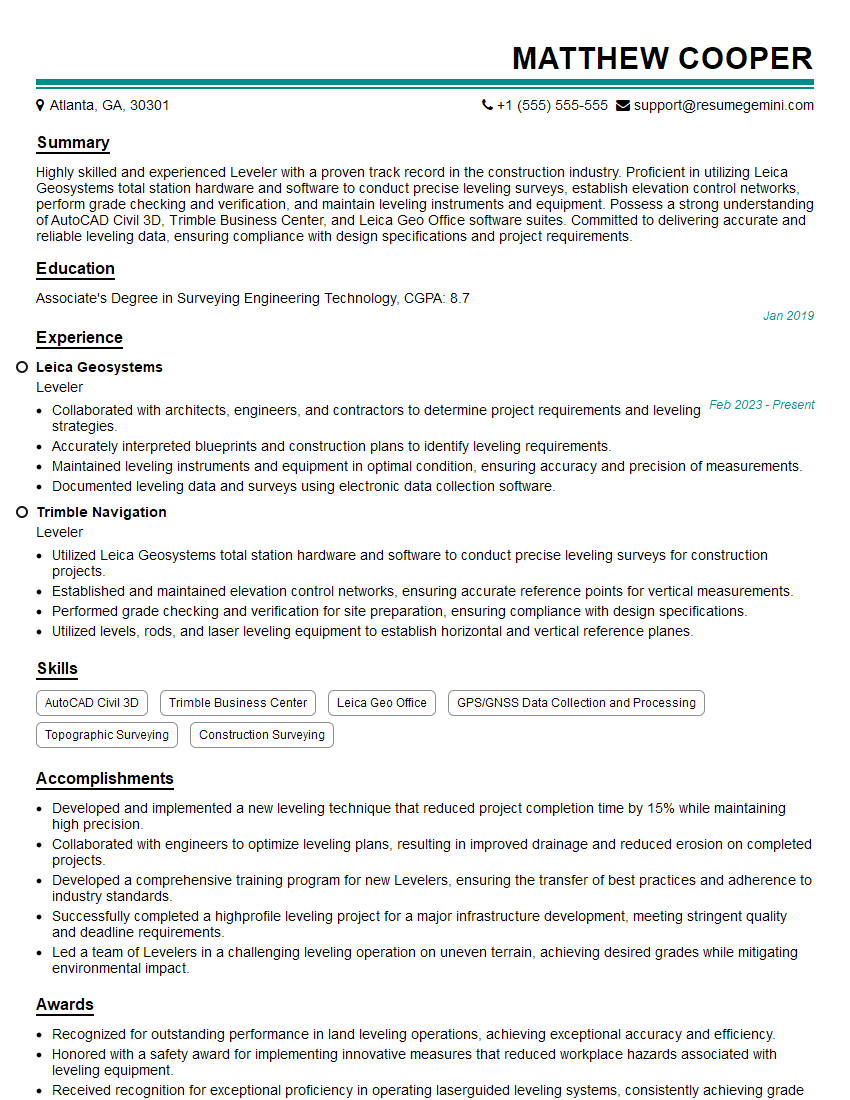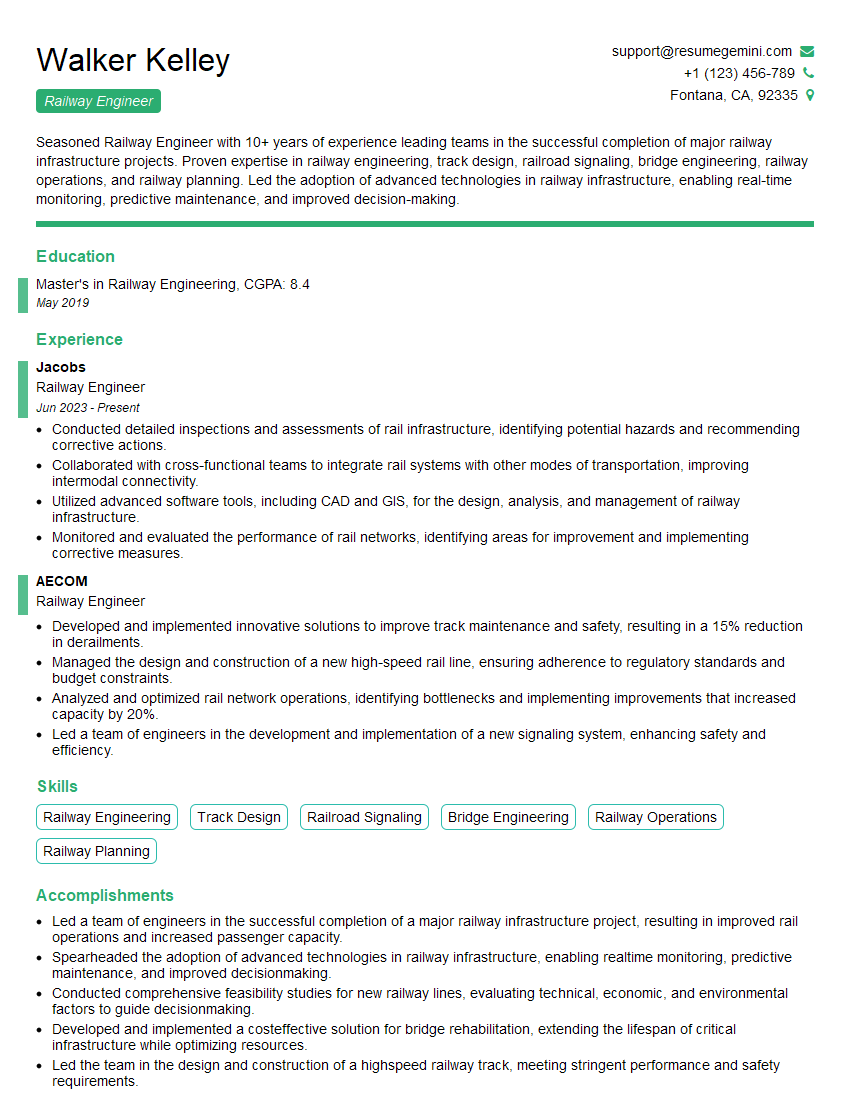Unlock your full potential by mastering the most common Cross-Slope Leveling interview questions. This blog offers a deep dive into the critical topics, ensuring you’re not only prepared to answer but to excel. With these insights, you’ll approach your interview with clarity and confidence.
Questions Asked in Cross-Slope Leveling Interview
Q 1. What are the common methods used for cross-slope leveling?
Cross-slope leveling, also known as transverse leveling, involves determining the slope of the ground perpendicular to the main line of a survey. Several methods achieve this, each with its strengths and weaknesses. The most common include:
Using a Level and Stadia Rod: This traditional method involves setting up a level at a known point and taking readings on a stadia rod held perpendicular to the line of sight at various points across the slope. The difference in readings, combined with the distance between points, gives the cross-slope.
Total Station with Slope Measurement: Modern total stations directly measure both horizontal and vertical distances, allowing for direct calculation of the cross-slope. This eliminates many of the errors associated with traditional methods.
Digital Level with Automated Target: These instruments automate the leveling process, increasing speed and accuracy. The automated target provides precise readings, reducing human error.
Differential GPS (DGPS): DGPS can determine the three-dimensional coordinates of points across the slope. The difference in elevations, combined with the horizontal distance between points, can then be used to compute the cross-slope. This is particularly useful in large areas or challenging terrain.
Q 2. Explain the importance of accurate cross-slope measurements in construction.
Accurate cross-slope measurements are crucial in construction for several reasons. They directly impact:
Drainage Design: Proper drainage is essential to prevent erosion, water damage, and foundation issues. Accurate cross-slopes ensure water flows away from structures and sensitive areas.
Road and Pavement Design: Cross-slopes dictate the transverse profile of roads and pavements, affecting vehicle stability and safety. An incorrectly calculated cross-slope can lead to water ponding, hydroplaning, and pavement damage.
Foundation Design: Foundations need to be level and stable. Cross-slope measurements help engineers determine the necessary adjustments to achieve a proper foundation, preventing settling and structural problems.
Grading and Earthworks: Accurate cross-slopes are vital for efficient and accurate earthmoving operations. They guide the removal and placement of earth to achieve the desired grade.
Cut and Fill Calculations: Determining precise cross-slopes helps in accurately calculating the volume of earth to be cut or filled, optimising material usage and project costs.
Q 3. Describe the different types of leveling instruments used in cross-slope leveling.
Various leveling instruments are employed for cross-slope leveling, each suited to different project scales and accuracy requirements:
Automatic Levels: These levels automatically compensate for slight tilts, improving accuracy and efficiency. They are widely used in most cross-slope leveling projects.
Digital Levels: These offer digital readout of the leveling staff readings, reducing the chance of manual recording errors. They often incorporate data logging capabilities for streamlined data processing.
Precise Levels: For high-precision applications, such as dam construction or precise alignment work, these offer exceptionally high accuracy. Their use is generally justified by the project’s critical nature and tolerance requirements.
Total Stations: Combining the capabilities of an electronic theodolite and an electronic distance meter (EDM), these instruments directly measure both horizontal and vertical distances, providing efficient and accurate cross-slope data.
Leveling Staffs or Rods: These graduated rods are used in conjunction with levels to obtain elevation readings.
Q 4. How do you account for curvature and refraction in cross-slope leveling?
Curvature and refraction affect long-sight leveling, causing errors in elevation measurements. These effects must be accounted for, especially in precise leveling applications. Curvature refers to the Earth’s curvature, causing the line of sight to be above the true horizontal, and refraction refers to the bending of light as it passes through the atmosphere.
While not directly measured during cross-slope leveling in the field (because distances across the slope are usually short), the effects could be significant if the cross slope is measured over a long distance. Correction formulas exist to compensate for these effects, commonly based on the length of sight and atmospheric conditions. However, these corrections are typically negligible for shorter distances commonly encountered in cross-slope leveling. For longer distances, software used in data processing should have incorporated these correction factors.
Q 5. What are the sources of error in cross-slope leveling, and how can they be minimized?
Several sources of error can affect the accuracy of cross-slope leveling:
Instrument Maladjustment: Improperly leveled instruments lead to inaccurate readings. Regular instrument calibration and maintenance are crucial.
Improper Rod Handling: Incorrect holding of the leveling rod can introduce significant errors. Ensuring the rod is plumb and held steadily is essential.
Sighting Errors: Incorrect focusing or misreading the rod graduations can lead to errors. Clear sightlines and careful reading are imperative.
Temperature Variations: Temperature changes can affect the length of the leveling rod, leading to errors. Using temperature-compensated rods or accounting for temperature effects during calculations is necessary.
Ground Instability: Unstable ground can affect the position of the leveling rod or instrument, causing inaccurate readings. Firm footing for both the instrument and the rod is crucial.
Human Error: Mistakes in recording or calculating data are common. Double-checking readings and using systematic data recording methods minimize this error.
Minimizing errors involves meticulous procedures, proper equipment use, and careful data handling. Employing techniques like double-running levels and performing independent checks significantly enhances accuracy.
Q 6. Explain the process of establishing benchmark points for cross-slope leveling.
Benchmark points, or BM’s, are points of known elevation used as references for leveling surveys. Establishing these for cross-slope leveling involves:
Selecting Stable Locations: Choose locations that are unlikely to shift or be disturbed, such as solid rock outcrops or permanent structures. Avoid areas prone to erosion or settlement.
Precise Elevation Determination: The elevation of the initial benchmark is determined through precise leveling methods, often connecting to a national geodetic network or a previously established control point.
Marking the Benchmarks: Clearly mark the benchmarks with durable markers, ensuring they are easily identifiable and their location is precisely recorded.
Recording Benchmark Information: Meticulously document the benchmark’s location, elevation, and any relevant identifying information. This documentation should include coordinates (if applicable).
Once established, these benchmarks serve as stable reference points for subsequent cross-slope leveling operations within the project area, simplifying the process and increasing consistency.
Q 7. How do you calculate cross-slopes from survey data?
Calculating cross-slopes from survey data depends on the method used to collect the data.
For traditional leveling with a level and rod:
1. Determine the difference in elevation between two points across the slope (Δh).
2. Measure the horizontal distance between those two points (Δx).
3. Calculate the cross-slope (S) using the formula: S = Δh / Δx. This will give you a result in units of rise or fall per unit of horizontal distance (e.g., meters/meter, feet/foot, or expressed as a percentage).
For total station data:
The total station directly provides the horizontal distance and elevation difference. The same formula (S = Δh / Δx) applies. Many total stations have built-in software to calculate cross slopes directly.
For DGPS data:
DGPS provides three-dimensional coordinates for each point. You would use the difference in elevation and the horizontal distance between points to calculate the cross-slope using the same formula. Software designed to process DGPS data typically performs these calculations automatically.
Remember to ensure consistent units throughout the calculation.
Q 8. Describe the procedure for checking the accuracy of cross-slope measurements.
Checking the accuracy of cross-slope measurements is crucial for ensuring proper grading and drainage. We primarily use two methods: independent verification and consistency checks.
Independent Verification: This involves a second, independent measurement of the cross-slope using a different instrument or technique. For instance, after using an automatic level and staff, we might verify the readings using a laser level or even a simpler method like a builder’s level and straight edge. Discrepancies between the two sets of measurements highlight potential errors.
Consistency Checks: This involves examining the consistency of the measurements across the entire area. Significant variations in cross-slope readings within short distances may indicate measurement errors or unexpected variations in the ground’s surface. We’d create a cross-section drawing and visually inspect for unexpected changes in slope. A smooth, consistent curve is expected, while sharp, abrupt changes might suggest an error. We might then re-measure the suspected areas to resolve inconsistencies.
Finally, checking the level’s calibration and the staff’s condition before starting is essential. Even minor errors in these elements can lead to significant inaccuracies in the cross-slope measurements.
Q 9. What are the safety precautions to be taken during cross-slope leveling?
Safety during cross-slope leveling is paramount. The work environment often involves uneven terrain, heavy equipment, and potentially hazardous conditions. The following precautions should be consistently applied:
- Proper Personal Protective Equipment (PPE): Always wear safety boots with steel toes, high-visibility clothing, safety glasses, and hard hats, especially when working near heavy machinery.
- Safe Work Practices: Maintain awareness of your surroundings. Be cautious of moving vehicles and equipment. Use warning signs and barricades to alert others of your presence and work area.
- Stable Positioning: Ensure your footing is secure while taking measurements. Avoid working on unstable ground or near drop-offs. Use caution on inclines and slopes.
- Communication: Maintain clear and constant communication with team members and equipment operators, especially in crowded work sites. Use hand signals or two-way radios as needed.
- Weather Conditions: Avoid working during adverse weather conditions such as rain, strong winds, or fog, as visibility and stability can be severely compromised.
- First Aid and Emergency Procedures: Know the location of the nearest first aid station and ensure emergency contact information is readily available.
Remember, safety is not just a set of rules; it’s a mindset that must be maintained throughout the entire process.
Q 10. How do you interpret cross-slope data to ensure proper grading?
Interpreting cross-slope data involves analyzing the measurements to determine if they meet the design specifications and ensure proper grading. This involves several key steps:
- Comparing to Design Specifications: The measured cross-slopes are compared to the design criteria specified in the project plans. For instance, a road might require a specific cross-slope for drainage, such as 2% (1 in 50). Significant deviations need investigation and potential correction.
- Creating Cross-Sections: Cross-section drawings visually represent the terrain’s cross-slope. These drawings show the elevation at different points across the site, allowing for a clear picture of the existing and desired slopes.
- Identifying High and Low Points: By analyzing the cross-sections, high and low points, and potential areas of ponding or inadequate drainage become evident. This helps pinpoint areas needing grading adjustments.
- Calculating Cut and Fill: Determining the amount of earth that needs to be cut or filled to achieve the desired cross-slope is essential. This involves calculating the volume of earth required for grading adjustments. Software can assist with these calculations.
- Analyzing Drainage Patterns: The cross-slope data directly impacts drainage patterns. An incorrect cross-slope can lead to water accumulation, erosion, or other drainage problems. The data is analyzed to ensure adequate drainage away from structures and towards designated drainage points.
Remember, the goal is to create a consistent and even slope that satisfies both design requirements and drainage needs. Corrective actions may include adding fill material, cutting away excess earth, or refining the grading process.
Q 11. Explain the relationship between cross-slope and drainage in site development.
Cross-slope is intrinsically linked to drainage in site development. Proper cross-slope ensures that water flows away from structures and sensitive areas, preventing water damage, erosion, and the creation of stagnant pools that become breeding grounds for insects. Think of it like a tilted roof; the water runs off, instead of pooling.
In designing drainage systems, the cross-slope is fundamental. We ensure a consistent, gradual slope directs water towards drainage channels, swales, or storm drains. Insufficient cross-slope leads to water accumulating on surfaces, potentially damaging pavements, foundations, and landscaping. Excessive cross-slope can cause rapid runoff, leading to erosion and the potential for localized flooding downstream.
Examples include designing roads with a slight camber (cross-slope) to direct water to the sides, or sloping a building’s foundation to divert water away from the walls. The design and positioning of drainage structures, such as culverts and ditches, are also heavily reliant on the established cross-slope.
Q 12. How does cross-slope leveling affect the design of roads and highways?
Cross-slope leveling is crucial for road and highway design, influencing safety, drainage, and structural integrity. The cross-slope, or camber, ensures that water drains effectively away from the road surface, preventing hydroplaning, ice formation, and pavement damage. Typically roads and highways have a slight crown or camber (a convex cross-slope) with water running off to the sides. This minimizes the risk of water accumulating on the road’s surface, improving safety conditions, particularly during periods of rain or snow.
The precise cross-slope chosen depends on several factors, including the road’s geometry, the climate, and the anticipated traffic volume. Steeper slopes might be necessary in areas with heavy rainfall, while gentler slopes may suffice in drier climates. The design also accounts for the road’s shoulder and drainage design, including the placement of gutters and ditches to direct water away from the roadway.
Incorrect cross-slopes can lead to structural problems over time, such as pavement deterioration and rutting due to water accumulation. This highlights the critical importance of accurate cross-slope leveling in road and highway construction.
Q 13. What is the significance of cross-slope in preventing erosion and sedimentation?
Proper cross-slope plays a vital role in preventing erosion and sedimentation. By directing water flow away from slopes and surfaces, it minimizes the erosive power of runoff. When water flows rapidly down a steep, unsloped surface, it carries away soil particles, leading to erosion and the formation of gullies. A well-designed cross-slope minimizes the velocity of the runoff, reducing its erosive capacity.
Furthermore, proper cross-slope prevents the accumulation of sediment in undesirable locations. Sediment transported by runoff can clog drainage channels, pollute waterways, and damage ecosystems. By controlling the flow of water, cross-slope helps to reduce sediment transport and deposition.
In areas prone to erosion, such as steep slopes or sandy soil, establishing appropriate cross-slopes is even more critical. This is often achieved through terracing, contour farming, or other soil conservation techniques. The goal is to create a stable surface that can effectively manage water flow and prevent erosion and sedimentation.
Q 14. Describe the impact of incorrect cross-slope on structural stability.
Incorrect cross-slope can significantly impact structural stability. For example, improper drainage due to insufficient cross-slope can lead to water accumulation around building foundations, causing hydrostatic pressure. This pressure can exert substantial upward forces on the foundation, potentially causing cracks, settling, and even structural failure. This is especially problematic in areas with high water tables or poor drainage.
On slopes, inadequate cross-slope can lead to landslides or soil instability. When water saturates the soil, its shear strength decreases, making it more susceptible to movement. Proper cross-sloping helps to prevent water saturation and maintains the soil’s stability. Conversely, excessive cross-sloping can create instability by causing localized erosion or undermining of structures.
In road construction, incorrect cross-slope can lead to pavement failure due to water penetration and freeze-thaw cycles. The consequences of incorrect cross-slope range from minor cosmetic issues to catastrophic structural failures, underscoring the importance of accurate measurements and proper grading.
Q 15. How do you handle challenging terrain during cross-slope leveling?
Challenging terrain significantly impacts cross-slope leveling accuracy. Obstacles like steep slopes, uneven surfaces, and dense vegetation require careful planning and adaptable techniques. My approach involves a combination of strategies. First, I conduct a thorough site reconnaissance to identify potential issues and plan the optimal survey route. This might involve breaking the area into smaller, more manageable sections. For extremely steep slopes, I utilize multiple instrument setups to ensure line of sight and minimize errors. In areas with dense vegetation, careful clearing is essential while ensuring minimal environmental impact. I also employ shorter instrument-to-rod distances to reduce errors associated with atmospheric refraction. Finally, I incorporate additional checkpoints and redundancy in my measurements to improve overall reliability.
For example, on a recent project involving a highly irregular hillside, we divided the area into smaller grids. Each grid was leveled individually using a combination of conventional leveling and trigonometric leveling techniques where necessary. This allowed us to overcome the limitations of a single setup and account for variations in elevation across the site.
Career Expert Tips:
- Ace those interviews! Prepare effectively by reviewing the Top 50 Most Common Interview Questions on ResumeGemini.
- Navigate your job search with confidence! Explore a wide range of Career Tips on ResumeGemini. Learn about common challenges and recommendations to overcome them.
- Craft the perfect resume! Master the Art of Resume Writing with ResumeGemini’s guide. Showcase your unique qualifications and achievements effectively.
- Don’t miss out on holiday savings! Build your dream resume with ResumeGemini’s ATS optimized templates.
Q 16. Explain the use of technology (e.g., GPS, total stations) in cross-slope leveling.
Modern technology plays a crucial role in increasing the efficiency and precision of cross-slope leveling. GPS (Global Positioning System) technology offers a powerful tool for establishing control points and determining elevations across large areas. Real-time kinematic (RTK) GPS provides centimeter-level accuracy, minimizing the reliance on traditional leveling techniques, particularly in open areas. Total stations, with their integrated electronic distance measurement (EDM) and angle measurement capabilities, offer a high-degree of precision for detailed cross-section surveys. They allow for quick and accurate data acquisition, significantly reducing fieldwork time and potential errors. The data collected is easily transferred to data processing software for analysis and reporting. Imagine needing to level a large construction site – using a total station for a precise base line and then using RTK GPS for more detailed elevations would be considerably faster and more accurate than traditional methods.
Q 17. What software or tools are commonly used for processing cross-slope data?
Several software packages are commonly utilized for processing cross-slope data. Civil 3D, AutoCAD Civil 3D, and other CAD software are widely used to create detailed cross-sections and longitudinal profiles, using data from total stations and GPS. These programs allow for easy visualization and analysis of the data. Specialized software such as Carlson Software and InRoads are also frequently used, particularly for large-scale projects that require detailed earthwork calculations. These programs are specifically designed to handle massive datasets and to perform complex calculations. In addition, many cloud-based solutions are appearing that allow for real-time data processing and collaboration.
Q 18. How do you ensure consistency and precision in cross-slope measurements?
Maintaining consistency and precision in cross-slope measurements requires meticulous attention to detail and adherence to standardized procedures. Calibration of instruments before each survey is paramount. This involves checking the level’s collimation and verifying the accuracy of the EDM in the total station. Regular instrument maintenance, including cleaning and adjustments, is crucial for minimizing systematic errors. Using proper leveling techniques, such as establishing a stable instrument setup, precise rod readings, and careful observation of the level bubble, further ensures data integrity. Employing multiple measurements at each point and implementing quality control checks, such as comparing readings between team members, can identify and correct any discrepancies.
For instance, we always employ a three-point check on our leveling rod readings. Each team member takes a reading, and if the variation exceeds a predetermined tolerance, we repeat the process until agreement is reached.
Q 19. Describe your experience with different soil types and their impact on cross-slope leveling.
Different soil types have a significant impact on cross-slope leveling, particularly in terms of stability and ease of instrument setup. Loose, sandy soils may require more stable instrument platforms to prevent settling and subsequent measurement errors. Clay soils, on the other hand, can be difficult to work with as they may stick to the instrument or rod, hindering precise readings. Rock formations pose challenges to both the instrument setup and rod placement, often requiring more time and effort to achieve accurate readings. Understanding these soil properties helps in choosing appropriate techniques and equipment. For example, on a site with highly compacted clay, we used specialized leveling rods with pointed tips to obtain stable ground contact. On loose sandy ground, we built wooden platforms for our instruments to ensure stability.
Q 20. How do you adapt your cross-slope leveling techniques to different project requirements?
Adapting cross-slope leveling techniques to meet project requirements is key to success. For small-scale projects, conventional leveling methods might suffice. For larger projects with intricate details, total stations or GPS technology would be employed. The level of precision required influences the techniques and equipment used. High-precision projects necessitate more meticulous measurements and error checks. Time constraints affect the choice of survey methods and the extent of quality control checks. Projects with limited access or sensitive environments necessitate customized solutions, such as using drones for surveying inaccessible areas.
For example, on a highway project, we needed to survey a long corridor quickly and efficiently. We employed a combination of GPS and total station technology to map the cross-sections across the corridor. However, for a smaller residential project with tighter tolerances, we opted for conventional leveling techniques, allowing for close visual control.
Q 21. Explain your understanding of legal and regulatory requirements related to cross-slope leveling.
Legal and regulatory compliance is paramount in cross-slope leveling. Adherence to local, state, and national surveying standards and regulations is essential to ensure the accuracy and legality of the survey data. This often involves using licensed surveyors and employing equipment that meets specific accuracy standards. Data collected must be properly documented and stored, adhering to any relevant data management regulations. Furthermore, understanding environmental regulations is crucial, particularly concerning land disturbance and protection of sensitive ecosystems during fieldwork. Ignoring these standards can lead to legal ramifications, project delays, and reputational damage. I always ensure to conduct our operations in strict adherence to all relevant legislation and regulations.
Q 22. How do you manage time effectively during cross-slope leveling projects?
Effective time management in cross-slope leveling is crucial for staying on schedule and within budget. It hinges on meticulous planning and execution.
- Detailed Project Planning: Before fieldwork begins, I create a comprehensive schedule outlining each stage – from initial site survey and instrument setup to data collection, analysis, and report generation. This involves breaking down the project into smaller, manageable tasks with assigned timelines.
- Resource Allocation: I carefully allocate resources, including personnel, equipment, and software, ensuring efficient utilization. This minimizes downtime and prevents bottlenecks.
- Prioritization: I prioritize tasks based on urgency and importance, focusing on critical path activities to maintain momentum. This often involves using tools like Gantt charts or project management software.
- Regular Monitoring & Adjustment: Throughout the project, I monitor progress against the schedule. If delays occur, I immediately identify the cause and implement corrective measures, which might include adjusting the schedule or reallocating resources.
- Effective Communication: Open and consistent communication with the project team and stakeholders is vital for proactive problem-solving and preventing time-wasting misunderstandings.
For instance, on a recent highway construction project, using a detailed Gantt chart allowed us to anticipate and mitigate potential delays caused by unexpected weather conditions, ultimately finishing the cross-slope leveling within the allocated timeframe.
Q 23. Describe a situation where you had to troubleshoot a problem during cross-slope leveling.
During a large-scale land development project, we encountered a significant challenge while performing cross-slope leveling. We were using automated leveling equipment, and unexpectedly, the data started exhibiting systematic errors—consistent deviations from expected values.
Initially, we suspected instrument malfunction. However, after thorough checks, the equipment proved to be functioning correctly. We then systematically investigated other potential causes:
- Environmental Factors: We examined whether atmospheric conditions (temperature, pressure, humidity) were affecting the instruments’ accuracy. While some minor adjustments were needed, this wasn’t the primary cause.
- Ground Conditions: We found that the ground was more unstable in certain areas, causing the leveling rod to settle unevenly. This was causing the readings to be skewed.
- Data Processing: We reviewed the data processing algorithms, and discovered a small bug in the software that was not properly accounting for some of the ground conditions in the calculations.
The solution involved using a combination of techniques: We implemented more rigorous ground stabilization procedures in problem areas and corrected the bug in the software. By carefully analyzing the data and systematically eliminating potential causes, we were able to rectify the issue and produce accurate results.
Q 24. How do you communicate technical information related to cross-slope leveling to non-technical audiences?
Communicating complex technical information about cross-slope leveling to non-technical audiences requires clear, concise language and effective visualization. I avoid using jargon and technical terms whenever possible.
- Analogies & Metaphors: I use relatable analogies to explain concepts. For example, I might explain the concept of cross-slope by comparing it to the slope of a roof or a hillside.
- Visual Aids: Diagrams, charts, and even simple sketches are invaluable. A visual representation of the data and the leveling process helps non-technical audiences grasp the key concepts more easily.
- Simplified Language: I break down complex procedures into smaller, easily understandable steps. I focus on explaining the purpose and outcome of each step rather than getting bogged down in the technical details.
- Interactive Demonstrations: Whenever possible, I incorporate hands-on demonstrations or interactive elements to make the explanation more engaging and memorable.
For example, when presenting to a group of city council members on a proposed road project, I used a simple model of the road and terrain with color-coded sections to highlight cross-slope variations and explain the importance of proper leveling for drainage and safety.
Q 25. What are the key performance indicators (KPIs) you use to evaluate the success of cross-slope leveling?
The success of cross-slope leveling is measured using several key performance indicators (KPIs):
- Accuracy: This is measured by comparing the measured cross-slope values with the design specifications. A small deviation is acceptable; however, consistent larger errors indicate a problem requiring investigation.
- Precision: This refers to the repeatability of measurements. Consistent readings across multiple measurements indicate high precision. This reflects the reliability of the equipment and the methodology used.
- Time Efficiency: The time taken to complete the leveling process compared to the planned schedule is a critical KPI. This reflects the efficiency of planning and execution.
- Cost Efficiency: The total cost of the leveling operation compared to the allocated budget is important for project management.
- Compliance: Adherence to relevant standards, regulations, and specifications ensures that the project meets required quality and safety standards.
For instance, a KPI target might be to achieve a cross-slope accuracy within ±2mm, complete the project within the scheduled timeframe, and stay within 95% of the allocated budget.
Q 26. How do you stay updated with the latest technologies and best practices in cross-slope leveling?
Staying updated in the rapidly evolving field of cross-slope leveling requires a proactive approach:
- Professional Organizations: I actively participate in professional organizations like the American Society of Civil Engineers (ASCE) and attend their conferences and workshops to learn about the latest advancements and best practices.
- Industry Publications: I regularly read industry journals and magazines to stay informed about new technologies and methodologies.
- Online Resources: I utilize online resources such as professional websites, online courses, and webinars offered by equipment manufacturers and industry experts.
- Networking: I actively network with colleagues and attend industry events to share experiences and learn from others’ successes and challenges.
- Continuing Education: I pursue continuing education opportunities through workshops and seminars to maintain and enhance my expertise in cross-slope leveling techniques and technologies.
For example, I recently completed a specialized training course on the use of advanced laser scanning technology for improved accuracy and efficiency in cross-slope leveling.
Q 27. Describe your experience working with cross-disciplinary teams on cross-slope leveling projects.
Cross-slope leveling projects often require collaboration with diverse teams, including surveyors, engineers, construction workers, and project managers. My experience working in such cross-disciplinary teams has been largely positive.
Effective communication and collaboration are key. I emphasize:
- Clear Communication: Ensuring everyone understands project goals, timelines, and individual responsibilities is critical. This requires proactive communication and clear documentation.
- Respectful Collaboration: I value the diverse perspectives and expertise each team member brings. I actively listen to their input and incorporate it into the project wherever appropriate.
- Problem-Solving as a Team: When challenges arise, I encourage a collaborative problem-solving approach. This involves brainstorming solutions together and leveraging the combined knowledge of the team.
- Regular Meetings: Regular meetings, both formal and informal, are essential for keeping the team informed and aligned. This allows for timely addressing of issues and maintenance of project momentum.
On a recent railway project, effective collaboration with the engineering team and construction crew ensured that the cross-slope leveling was integrated seamlessly with the overall track construction, resulting in a smooth, on-time project completion.
Q 28. How do you ensure quality control and quality assurance in your cross-slope leveling work?
Quality control and quality assurance (QA/QC) are paramount in cross-slope leveling. I implement a multi-layered approach to ensure accuracy and reliability:
- Instrument Calibration: Regular calibration of leveling equipment is essential. This involves checking and adjusting the instruments to ensure they meet the required accuracy standards.
- Redundant Measurements: I always take redundant measurements at each point and compare results. Discrepancies exceeding acceptable tolerances trigger further investigation.
- Independent Checks: Independent checks of the data analysis and calculations are conducted to verify the results. This helps to detect and correct potential errors.
- Data Review: Thorough review of the collected data is crucial. This includes checking for outliers, inconsistencies, and errors in data recording.
- Documentation: Meticulous record-keeping of all measurements, calculations, and adjustments is crucial. This provides an audit trail for verifying accuracy and identifying potential issues.
For example, during a large-scale building site, a systematic QC procedure identifying a slight systematic error in one segment of the leveling process allowed us to correct the readings before the error propagated into the broader project, saving time and resources.
Key Topics to Learn for Cross-Slope Leveling Interview
- Understanding Cross-Slope Principles: Grasp the fundamental concepts behind establishing and maintaining consistent cross-slopes in various applications. This includes understanding the impact of slope on drainage and stability.
- Methods of Cross-Slope Measurement: Familiarize yourself with different techniques used to accurately measure cross-slopes, including the use of levels, instruments and surveying technology. Understand the limitations and precision of each method.
- Calculating Cross-Slope: Practice calculating cross-slope percentages and gradients. Be prepared to demonstrate your ability to apply these calculations in real-world scenarios, ensuring accurate estimations and designs.
- Applications in Construction and Engineering: Understand the practical applications of cross-slope leveling in various construction projects such as roads, pavements, landscaping, and site drainage. Be ready to discuss specific examples and challenges.
- Troubleshooting and Error Correction: Develop your problem-solving skills by considering potential issues that might arise during cross-slope leveling and how to address them efficiently and effectively. This includes understanding sources of error and how to minimize them.
- Safety Procedures and Regulations: Demonstrate awareness of relevant safety regulations and procedures associated with cross-slope leveling and site surveying. This showcases your commitment to safe work practices.
- Software and Technology: Be familiar with relevant software and technology commonly used in cross-slope leveling and surveying. Knowing the capabilities and limitations of various tools will demonstrate your technical proficiency.
Next Steps
Mastering Cross-Slope Leveling is crucial for advancing your career in construction, engineering, and related fields. It demonstrates a strong foundation in precision, problem-solving, and practical application of theoretical knowledge. To significantly boost your job prospects, creating a strong, ATS-friendly resume is essential. ResumeGemini is a trusted resource to help you build a professional and impactful resume that highlights your skills and experience effectively. Examples of resumes tailored specifically to Cross-Slope Leveling are available to provide you with valuable guidance and inspiration.
Explore more articles
Users Rating of Our Blogs
Share Your Experience
We value your feedback! Please rate our content and share your thoughts (optional).
What Readers Say About Our Blog
Dear Sir/Madam,
Do you want to become a vendor/supplier/service provider of Delta Air Lines, Inc.? We are looking for a reliable, innovative and fair partner for 2025/2026 series tender projects, tasks and contracts. Kindly indicate your interest by requesting a pre-qualification questionnaire. With this information, we will analyze whether you meet the minimum requirements to collaborate with us.
Best regards,
Carey Richardson
V.P. – Corporate Audit and Enterprise Risk Management
Delta Air Lines Inc
Group Procurement & Contracts Center
1030 Delta Boulevard,
Atlanta, GA 30354-1989
United States
+1(470) 982-2456
